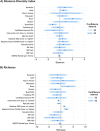Water source, latrine type, and rainfall are associated with detection of non-optimal and enteric bacteria in the vaginal microbiome: a prospective observational cohort study nested within a cluster randomized controlled trial
- PMID: 39695422
- PMCID: PMC11653966
- DOI: 10.1186/s12879-024-10313-3
Water source, latrine type, and rainfall are associated with detection of non-optimal and enteric bacteria in the vaginal microbiome: a prospective observational cohort study nested within a cluster randomized controlled trial
Abstract
Background: Less than one-third of sub-Saharan Africans have access to improved water sources. In US, Indian, and African studies, Bacterial vaginosis (BV) is increased among women with poor water, sanitation, and hygiene (WASH). We examined water source, sanitation (latrine type), and rainfall in relation to the vaginal microbiome (VMB).
Methods: In a cluster randomized controlled trial of menstrual cups and cash transfer, we measured the impact of cups on VMB via 16S rRNA gene amplicon sequencing in a subset of 436 adolescent girls. We analyzed how self-reported water source and latrine type at home related to VMB over 18-months, examining community state type I (CST-I, L. crispatus dominant) vs. other CST; alpha diversity; targeted taxa (coliform and other water-related pathogens); and non-targeted taxa via machine learning approaches. Mixed effects multivariable longitudinal models were adjusted for intervention arm, age, socioeconomic status, sexual activity, and cluster-level school WASH and rainfall (in millimeters).
Results: Adjusting for all covariates in all models: (1) the odds of CST-I were increased among participants with piped water (vs. pond), and decreased with traditional pit latrine vs. flush toilet. (2) Alpha diversity varied by water source and latrine type without consistent trends. (3) Coliform bacteria relative abundance (RA) was higher among participants with traditional pit or ventilated improved pit latrines vs. flush toilet, and higher among participants relying on stream vs. pond water. Streptococcus agalactiae RA was higher among participants with non-flush toilets, while Bacteroides fragilis RA was lower with non-flush toilets. (4) Key taxa from non-targeted analyses associated with water source and latrine type included typical vaginal bacteria, opportunistic pathogens, and urinary tract pathobionts. (6) Increased rainfall was associated with decreased odds of CST-I.
Trial registration: ClinicalTrials.gov NCT03051789, February 14, 2017.
Keywords: Bacterial vaginosis; Climate change; Latrine; Menstrual hygiene management; Vaginal microbiome; WASH; Water; Water sanitation and hygiene.
© 2024. The Author(s).
Conflict of interest statement
Declarations. Ethics approval and consent to participate: Ethics committees approved this study by the following names of the Institutional Review Boards (reference number): Kenya Medical Research Institutes (KEMRI, SERU #3215), Liverpool School of Tropical Medicine (LSTM, #15-005), and University of Illinois at Chicago (UIC, #2017-1301). Written informed parental consent and written informed assent from minors was obtained for all participants. Consent for publication: Not applicable. Competing interests: The authors declare no competing interests.
Figures



Similar articles
-
Analysis of bacterial vaginosis, the vaginal microbiome, and sexually transmitted infections following the provision of menstrual cups in Kenyan schools: Results of a nested study within a cluster randomized controlled trial.PLoS Med. 2023 Jul 25;20(7):e1004258. doi: 10.1371/journal.pmed.1004258. eCollection 2023 Jul. PLoS Med. 2023. PMID: 37490459 Free PMC article. Clinical Trial.
-
High Prevalence of Lactobacillus crispatus Dominated Vaginal Microbiome Among Kenyan Secondary School Girls: Negative Effects of Poor Quality Menstrual Hygiene Management and Sexual Activity.Front Cell Infect Microbiol. 2021 Sep 21;11:716537. doi: 10.3389/fcimb.2021.716537. eCollection 2021. Front Cell Infect Microbiol. 2021. PMID: 34621690 Free PMC article.
-
Assessment of the Status of Water, Sanitation and Hygiene (WASH) Services at Primary Schools in uMfolozi Local Municipality, Kwa-Zulu Natal, South Africa.Int J Environ Res Public Health. 2025 Feb 28;22(3):360. doi: 10.3390/ijerph22030360. Int J Environ Res Public Health. 2025. PMID: 40238358 Free PMC article.
-
The pit latrine paradox in low-income settings: A sanitation technology of choice or a pollution hotspot?Sci Total Environ. 2023 Jun 25;879:163179. doi: 10.1016/j.scitotenv.2023.163179. Epub 2023 Mar 31. Sci Total Environ. 2023. PMID: 37003330 Review.
-
Interventions to improve disposal of child faeces for preventing diarrhoea and soil-transmitted helminth infection.Cochrane Database Syst Rev. 2019 Sep 24;9(9):CD011055. doi: 10.1002/14651858.CD011055.pub2. Cochrane Database Syst Rev. 2019. PMID: 31549742 Free PMC article.
References
-
- Fils LRN. Linking Water Access and Education in the Sustainable Development Goals in Sub-saharan Africa. Asian J Empir Res. 2021;11:50–8. 10.18488/journal.1007.2021.116.50.58.
-
- Lin L, Yang H, Xu X. Effects of Water Pollution on Human Health and Disease Heterogeneity: a review. Front Environ Sci. 2022; 10:880246. 10.3389/fenvs.2022.880246.
-
- Peebles K, Velloza J, Balkus JE, et al. High global burden and costs of bacterial vaginosis: a systematic review and Meta-analysis. Sex Transm Dis. 2019;46:304–11. 10.1097/OLQ.0000000000000972. - PubMed
Publication types
MeSH terms
Substances
Associated data
Grants and funding
- R01HD093780/NH/NIH HHS/United States
- R01HD093780/NH/NIH HHS/United States
- R01HD093780/NH/NIH HHS/United States
- R01HD093780/NH/NIH HHS/United States
- R01HD093780/NH/NIH HHS/United States
- R01HD093780/NH/NIH HHS/United States
- R01HD093780/NH/NIH HHS/United States
- R01HD093780/NH/NIH HHS/United States
- MR/N006046/1/MRC_/Medical Research Council/United Kingdom
- MR/N006046/1/MRC_/Medical Research Council/United Kingdom
- MR/N006046/1/MRC_/Medical Research Council/United Kingdom
- MR/N006046/1/MRC_/Medical Research Council/United Kingdom
LinkOut - more resources
Full Text Sources
Medical

